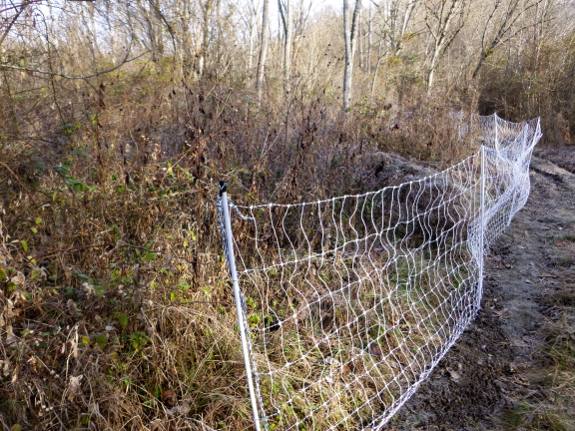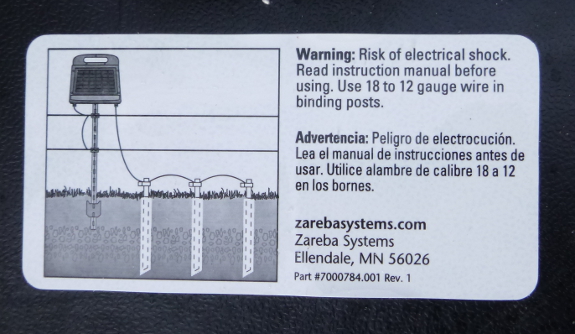
Poultry netting for goats

Daddy lent us a solar
charger plus two 164-foot lengths of poultry netting for goat
experimentation. (Thank you!!) Of course, I immediately came up with a
slew of questions, such as...
...Will the fencing work if I run it through heavy weeds, just knocking a path open with my foot?

...Do we really need the
three deep grounding rods we're instructed to install if I'm grounding
the fencing in what's basically a swamp? And do people who move
temporary electric fencing daily really drive in multiple grounding rods
(and then pull them back out) at each location?
...How long will the charger have to soak up sunlight during a cloudy, winter period to save up enough juice to shock our goats?
...Will our goats remember the electric netting both were living in a couple of months ago, or will they have to be retrained?
...Did Daddy really think that, if this works, he's ever getting his expensive hardware back?
Want more in-depth information? Browse through our books.
Or explore more posts by date or by subject.
About us: Anna Hess and Mark Hamilton spent over a decade living self-sufficiently in the mountains of Virginia before moving north to start over from scratch in the foothills of Ohio. They've experimented with permaculture, no-till gardening, trailersteading, home-based microbusinesses and much more, writing about their adventures in both blogs and books.
Want to be notified when new comments are posted on this page? Click on the RSS button after you add a comment to subscribe to the comment feed, or simply check the box beside "email replies to me" while writing your comment.

I'd say Warren Wilson graduates might have answers to your questions! The whole thing looks like they would just step it down to the ground, if you put it thru a weed patch. Also, I'd watch out for negative reinforcements, since they know that ultimately you will rescue them. I don't really know how to Train a goat... I also think that just tying each one would ensure that you knew where they were at all times, if you are busy, and need to protect them from deer hunters--for which, btw, you might try belling each one?
Anna,
While we don't keep goats, we did keep 2 hogs this year. One is about 225lbs and the other about 300-325lbs. They have torn their house down twice they are so big. I say all of that because we have a solar charger and ours came with the same illustrations and instructions for 3 grounding rods. We use 1 pretty long rod, about 3-4ft in the soil, 2ft out of soil. The perimeter of the fencing comes out to around 80-100ft, and is a single woven poly wire about 2'6" above the ground. A few weeds do not seem to bother it; a big clump, or a few that are wet, is the very thing that allowed our pigs freedom both times they have managed to take the fence down. Cloudy days do not seem to inhibit the charging at all, and as a matter of fact, our charger has been knocked down and landed solar panel down, and has continued to shock for the entire day. I have a suspicion that the battery holds more energy than required for 1 or even 2 days. Especially if your fencing is clean. But I'm too lazy to do the math. Anyway, the pigs quickly learned what the fence was and listened for the sound of the pulse as it cycled through the fence. They discovered that pushing a straw bale into their mud hole and then on into the fence would ground the fence out and they could take it down. The second time was my fault , as some loose straw found it's way onto a section of fence that I had forgotten about...whoops! Good thing the electric fence was only layer one of containment, as they also had a wooden plank fence around that, divided and connected by gate to make 2 pastures. We have also used the same set up around a 50'x250' garden area to keep cattle out. It worked perfectly with about 25 head of cattle.Hope these experiences helps to make your experiments a little easier to design!! Happy holidays!
We've had those fences for going on 16 years now, and they work great. Most of ours are powered by a 12 volt marine battery due to no power to most areas of the farm, and the batteries last 5 - 7 years. Never felt the need to spring for a solar energizer.
Because we already have permanent fencing we run a lead wire for electrifying and have 2 permanent ground rods. Rolling out a spool of wire to electrify the netting is much easier than moving energizer, and ground rods. But that may just be me. A friend has the setup that you move the energizer and small ground rod...her animals escape frequently. Personally I would rather deal with a Little extra fencing chores than rounding up errant livestock. You almost never find them until they've gotten into trouble.
We're also using two 164' sections and an older section that is 100', powered by a 12 volt car battery (the chicken pasture has the 12 volt marine battery). Both batteries work equally well. Half a day on the battery charger and the fence has power for a good 3-4 weeks.
If weeds touch the fencing it seems to drain the battery pretty quick. I keep a spool of string handy that is the exact length of my fencing...I'll lay it on the ground in the shape I want my new pasture to be, then mow just outside the perimeter of the string. When I move my fencing it almost always falls within the new path I mowed. It really makes moving things around more efficient.
For a ground rod I just use an old 5' section of 1/2" copper pipe and hammer it into the ground a few feet. It works like a charm even in the drier, sandy soil of coastal Georgia. It's also easy to pull out of the ground when I move the pasture.
The fence is currently holding in 6 Lamanchas and 4 Nigerians. (more fencing is on the way) We move the fencing often and they never challenge it. Whenever we've added a new goat, they'll get a shock on the snout once or twice and that's all the education they need (again, intact males are another story).
And yes, if you're as pleased with it as I've been, your dad will never again see his fence unless he comes to your place to look at it. That's been my experience, your mileage may vary.
They most certainly will remember the hot wire and respect it. You need to be careful when pulling the Premier netting out of the ground. Honestly it is my LEAST favorite netting. The posts will pull out of the stobs if you are not careful. To fix them, you just heat the stob with a blow torch and shove it back on the plastic post, but it's a PITB. I prefer the Kencove netting - better posts. It is lighter and seems to handle mountain contours better. I do like the Premier chicken netting for training babies because they are less likely to stick their head through and get tangled or run through the fence.
You can use a positive/negative fence setup - I've never done it but you could try that and see how that works.
I would say you could also experiment with less/shorter grounding rod and use your fence tester to see what kind of shock you are getting.